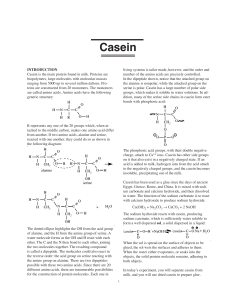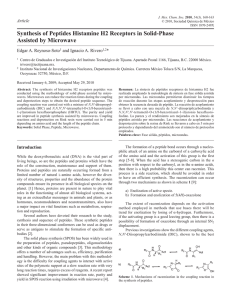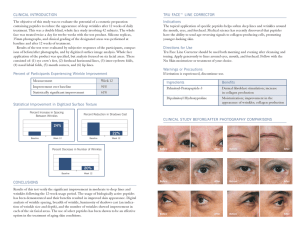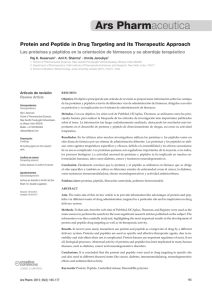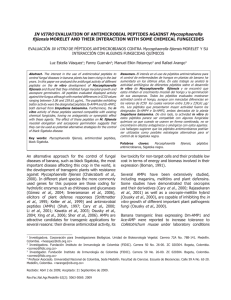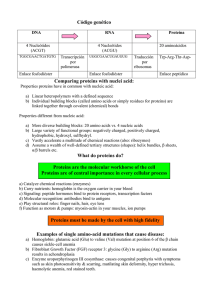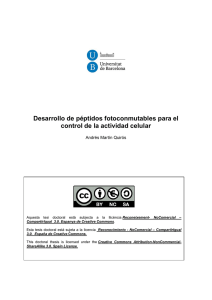Analysis of Peptide Profiles of Casein Hydrolysates Prepared with
Anuncio
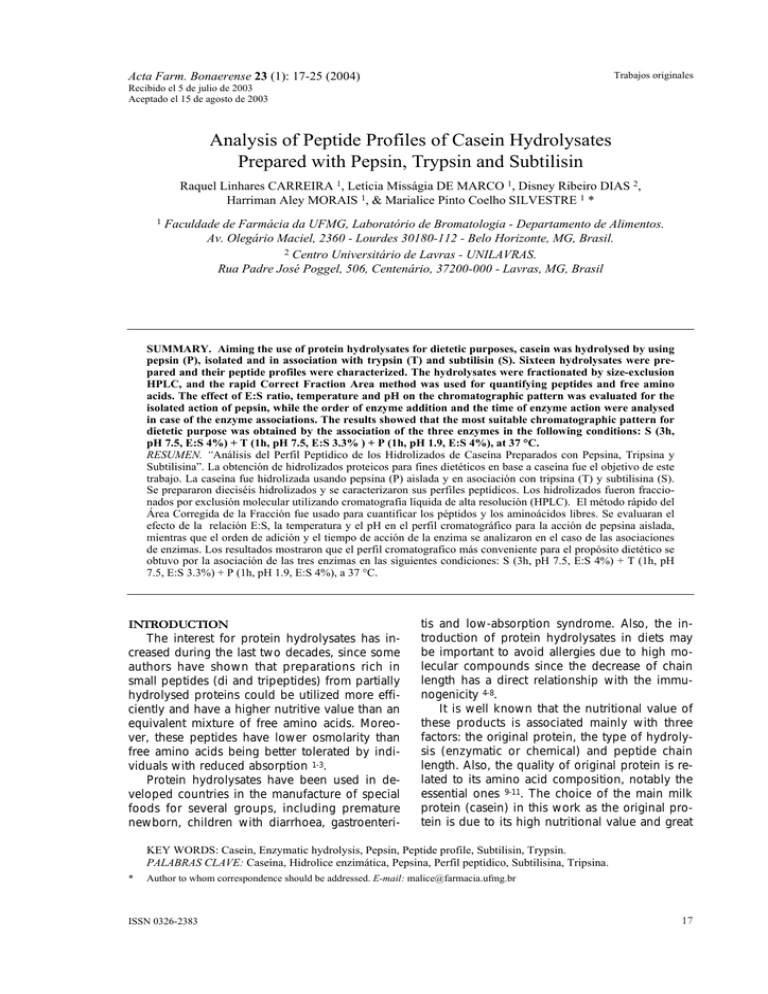
Trabajos originales Acta Farm. Bonaerense 23 (1): 17-25 (2004) Recibido el 5 de julio de 2003 Aceptado el 15 de agosto de 2003 Analysis of Peptide Profiles of Casein Hydrolysates Prepared with Pepsin, Trypsin and Subtilisin Raquel Linhares CARREIRA 1, Letícia Misságia DE MARCO 1, Disney Ribeiro DIAS 2, Harriman Aley MORAIS 1, & Marialice Pinto Coelho SILVESTRE 1 * 1 Faculdade de Farmácia da UFMG, Laboratório de Bromatologia - Departamento de Alimentos. Av. Olegário Maciel, 2360 - Lourdes 30180-112 - Belo Horizonte, MG, Brasil. 2 Centro Universitário de Lavras - UNILAVRAS. Rua Padre José Poggel, 506, Centenário, 37200-000 - Lavras, MG, Brasil SUMMARY. Aiming the use of protein hydrolysates for dietetic purposes, casein was hydrolysed by using pepsin (P), isolated and in association with trypsin (T) and subtilisin (S). Sixteen hydrolysates were prepared and their peptide profiles were characterized. The hydrolysates were fractionated by size-exclusion HPLC, and the rapid Correct Fraction Area method was used for quantifying peptides and free amino acids. The effect of E:S ratio, temperature and pH on the chromatographic pattern was evaluated for the isolated action of pepsin, while the order of enzyme addition and the time of enzyme action were analysed in case of the enzyme associations. The results showed that the most suitable chromatographic pattern for dietetic purpose was obtained by the association of the three enzymes in the following conditions: S (3h, pH 7.5, E:S 4%) + T (1h, pH 7.5, E:S 3.3% ) + P (1h, pH 1.9, E:S 4%), at 37 °C. RESUMEN. “Análisis del Perfil Peptídico de los Hidrolizados de Caseína Preparados con Pepsina, Tripsina y Subtilisina”. La obtención de hidrolizados proteicos para fines dietéticos en base a caseína fue el objetivo de este trabajo. La caseína fue hidrolizada usando pepsina (P) aislada y en asociación con tripsina (T) y subtilisina (S). Se prepararon dieciséis hidrolizados y se caracterizaron sus perfiles peptídicos. Los hidrolizados fueron fraccionados por exclusión molecular utilizando cromatografía líquida de alta resolución (HPLC). El método rápido del Área Corregida de la Fracción fue usado para cuantificar los péptidos y los aminoácidos libres. Se evaluaran el efecto de la relación E:S, la temperatura y el pH en el perfil cromatográfico para la acción de pepsina aislada, mientras que el orden de adición y el tiempo de acción de la enzima se analizaron en el caso de las asociaciones de enzimas. Los resultados mostraron que el perfil cromatografico más conveniente para el propósito dietético se obtuvo por la asociación de las tres enzimas en las siguientes condiciones: S (3h, pH 7.5, E:S 4%) + T (1h, pH 7.5, E:S 3.3%) + P (1h, pH 1.9, E:S 4%), a 37 °C. INTRODUCTION The interest for protein hydrolysates has increased during the last two decades, since some authors have shown that preparations rich in small peptides (di and tripeptides) from partially hydrolysed proteins could be utilized more efficiently and have a higher nutritive value than an equivalent mixture of free amino acids. Moreover, these peptides have lower osmolarity than free amino acids being better tolerated by individuals with reduced absorption 1-3. Protein hydrolysates have been used in developed countries in the manufacture of special foods for several groups, including premature newborn, children with diarrhoea, gastroenteri- tis and low-absorption syndrome. Also, the introduction of protein hydrolysates in diets may be important to avoid allergies due to high molecular compounds since the decrease of chain length has a direct relationship with the immunogenicity 4-8. It is well known that the nutritional value of these products is associated mainly with three factors: the original protein, the type of hydrolysis (enzymatic or chemical) and peptide chain length. Also, the quality of original protein is related to its amino acid composition, notably the essential ones 9-11. The choice of the main milk protein (casein) in this work as the original protein is due to its high nutritional value and great KEY WORDS: Casein, Enzymatic hydrolysis, Pepsin, Peptide profile, Subtilisin, Trypsin. PALABRAS CLAVE: Caseína, Hidrolice enzimática, Pepsina, Perfil peptídico, Subtilisina, Tripsina. * Author to whom correspondence should be addressed. E-mail: [email protected] ISSN 0326-2383 17 Carreira, R.L., L.M. De Marco, D.R. Días, H.A. Morais, & M.P.C. Silvestre susceptibility to the catalytic action of proteases 12. Considering that in our country, the formulations normally used as dietetic supplements must be imported and, consequently, are highprice products, our interest turned to the preparation of these formulations, having protein hydrolysates as the main source of amino acids in a high available form, that is, in oligopeptide form, especially di and tripeptides. This is the reason we have been preparing several protein hydrolysates and testing different hydrolytic conditions in the obtaining of peptide profiles appropriate for nutritional purposes 13,14. For characterizing the peptide profiles of protein hydrolysates, we developed a technique which consists in a first fractionation of peptides according to their chain size, followed by a quantification of these peptides by a rapid method based on the estimation of the corrected fraction area, after the removal of aromatic amino acid influence 15. The aim of the present work was to analyse the peptide profiles of casein hydrolysates prepared by using pepsin, isolated and in association with trypsin and subtilisin. and a fraction colector (Pharmacia-Frac 100, EUA). A poly (2-hydroxyethylaspartamide)-silica (PHEA) column, 250 x 9.4 mm, 5 µm, 200 Å pore size (PolylC, Columbia, MD), was used for HPLC. Trypsin (type XIII, TPCK treated, from bovine pancreas), pepsin (P6887), subtilisin (Carlsberg, type VIII, from Bacillus licheniformis) and casein (C7078) were purchased from Sigma (St. Louis, MO). Hydrochloric and formic acids (98100% grade, analytical grade) were obtained from Merck (Darmstadt, Germany). For HPLC, water was purified by passage through a Milli-Q water purification system (AriesVaponics, EUA). All solvents used for the HPLC were carefully degassed by sonication for 10 min before use. Methods Preparation of casein hydrolysates Sixteen hydrolysates were prepared from bovine milk casein. The temperature of a 0.25% solution of casein in 0.01 M phosphate buffer (pH 1.9 and 7.5) was adjusted to the values indicated for each case in table 1, and the enzymes (pepsin, trypsin and subtilisin,) were added in such a concentration to obtain the desired E:S ratio (Table 1). For most of hydrolysates, the total time of hydrolysis was 5h, for three preparations (H5, H8 and H11) the hydrolysis lasted 3h and for H6 it lasted 1h. The other parameters of hydrolysis are listed in Table 1. MATERIAL AND METHODS Material The HPLC system consisted of one pump (HP 1100 Series), an UV-VIS detector, coupled to a computer (HPchemstation HP1100, Germany) Use of pepsin (P) Isolated Associated with trypsin (T) Associated with trypsin (T) and subtilisin (S) PH Temp. (°C) P T E:S (%) S P H1 5h 40 1,9 2 H2 5h 40 1,9 4 H3 5h 40 2,5 4 H4 5h 37 1,9 4 H5 3h 40 1,9 4 H6 1h 40 1,9 4 H7 5h 60 1,9 4 T H8 P (1h) + T (2h) 37 1,9 7,5 4 3,3 H9 P (2h) + T (3h) 37 1,9 7,5 4 3,3 H10 P (3h) + T (2h) 37 1,9 7,5 4 3,3 H11 T (2h) +P (1h) 37 1,9 7,5 4 3,3 H12 T (3h) +P (2h) 37 1,9 7,5 4 3,3 H13 T (2h) +P (3h) 37 1,9 7,5 4 3,3 S H14 T (1h) +P (1h) + S (3h) 37 1,9 7,5 7,5 4 3,3 4 H15 T (1h) + S (3h) + P (1h) 37 1,9 7,5 7,5 4 3,3 4 H16 S (3h) + T (1h) + P(1h) 37 1,9 7,5 7,5 4 3,3 4 Table 1. Hydrolytic parameters for preparing casein hydrolysates. E: S = enzyme: substrate ratio; Temp. = temperature. 18 acta farmacéutica bonaerense - vol. 23 n° 1 - año 2004 The fractionation of casein hydrolysates was carried out on a PHEA column, as described by our group 13,15 using 0.05 M formic acid as the mobile phase at a flow rate of 0.5 mL·min–1. Fifty microliters of 8 µg.µL–1 hydrolysate solutions were injected on the column. Peptides were detected at three wavelengths: 230, 280 and 300 nm. The fractions were separated according to the elution time: F1, from 13,2 to 18,2 min; F2, from 18,2 to 21,7 min; F3, from 21,7 to 22,7 min; and F4, from 22,7 to 32 min. Quantification of peptides and free amino acids in casein hydrolysates The rapid method of Correct Fraction Area (CFA) developed by our group 13 was used for quantifying peptides and free amino acids in fractions of casein hydrolysates. The samples were fractionated by size-exclusion-HPLC (SEHPLC) and the CFA values calculated with the aid of a standard curve, prepared as described before 13. Figure 1. Chromatographic profile of hydrolysate H9 at 230 nm. F1: large peptides (> 7 aminoacid residues); F2: medium peptides (4 to 7 aminoacid residues); F3: di- and tripeptides; F4: free aminoacids; Y = tyrosine; W = tryptophan. Statistical analysis All experiments were replicated three times and all measurements were carried out in triplicate. Treatment effects (different hydrolytic conditions) were analysed using ANOVA and the differences between treatments means were determined by the multiple range test 16. Differences were considered to be significant at p<0.05 throughout this study. The least square method was used to fit the standard curve and the adequacy of the linear model (Y = βX) was tested at p<0.05. Several authors have described the fractionation of protein hydrolysates based on peptide chain length. However, most of the described techniques concern the separation of peptides of high molecular mass (>1,000 Da). The main reported methods are sodium dodecyl sulphatepolyacrylamide gel electrophoresis (SDS-PAGE) 17-19; size-exclusion chromatography (SEC) 12,2024; capillar HPLC 25; ligand exchange-HPLC, LEHPLC 26-28 and SE-HPLC 29-31. These techniques showed some inconvenience, like hydrophobic and electrostatic interactions between solute molecules and the matrix 32,33, and the inefficiency in separating small peptides 34,35. The use of SEC and LE-HPLC showed to be able to separate only peptides from amino acids. The SEHPLC and capillary HPLC failed to separate peptides based on their chain length and several molecular weight overlaps have been reported 25,30. RESULTS AND DISCUSSION Fractionation of casein hydrolysates by High-Performance Size Exclusion Chromatography (SE-HPLC) The chromatographic pattern of a casein hydrolysate (H9) is shown in Fig. 1. As previously described by our group 14,15, the casein hydrolysates were resolved in four fractions. Fraction 1 corresponding to peptides containing more than 7 amino acid residues, fraction 2 to those containing from 4 to 7 residues, fraction 3 to those containing 2 and 3 residues and fraction 4 to free amino acids. The last two peaks in fraction 4 correspond to tyrosine (peak Y) and tryptophan (peak W). The SE-HPLC technique used showed to be efficient in fractionating protein hydrolysates, especially peptides of molecular mass lower than 1,000 Da, as previously reported by our group 14,15. Comparison between different enzymatic treatments Isolated action of pepsin Effect of E:S ratio The effect of E:S ratio on the isolated action of pepsin over casein can be evaluated in Figure 2. The two-fold increase of E:S ratio from 2 to 4% (hydrolysates H1 and H2, respectively), led to a higher level of di and tripeptides from 2% to 10%, although no change was observed for F1, F2 and F4 contents. In this way, this change in the E:S ratio showed to be an advantageous option from a nutritional point of view, but it should be economically evaluated for industrial use. Taking in account the major affinity points of pepsin over the casein molecule, this increase in di and tripeptide contents, due to a higher amount of added enzyme, was expected 36-38. In a previous study in our laboratory 14, 19 Carreira, R.L., L.M. De Marco, D.R. Días, H.A. Morais, & M.P.C. Silvestre Figure 2. Isolated action of pepsin: effect of E:S ratio. H1, E:S = 2%; H2, E:S = 4%. Each value represents the mean of triple determination. Different numbers are significantly different (p ≤ 0.05) for different fractions of the same hydrolysate. Different letters are significantly different (p ≤ 0.05) for the same fraction of different hydrolysates. Figure 3. Isolated action of pepsin: effect of temperature. H2: 40 ºC; H4: 37ºC; H7: 60 ºC. Each value represents the mean of triple determination. Different numbers are significantly different (p ≤ 0.05) for different fractions of the same hydrolysate. .Different letters are significantly different (p ≤ 0.05) for the same fraction of different hydrolysates. when the E:S ratio of subtilisin was increased in the same proportion for the preparation of casein hydrolysates, besides an increase in di and tripetide contents, a significant change was also observed for the other fractions, i.e., a decrease of large peptide and free amino acid contents and an increase of medium peptides. Loosen et al. 10 changed the E:S ratio from 1 to 4%, and the best results were obtained in a 2% E:S ratio, which produced a hydrolysate with 75% of di and tripeptides and less than 5% of free amino acids. These results contradict the statement of González-Tello et al. 7, who sustained that a modification in the E:S ratio has no influence on the distribution of peptides in chromatographic fractions of protein hydrolysates. On the other side, Freitas et al. 39 failed to change the chromatographic pattern of a casein hydrolysate by a 3.7 fold increase in pancreatin concentration. According to these authors this apparent limit in casein hydrolysis may be related, at least in part, to the amino acid sequence in casein chain and to the specificity of the enzyme used. Although these results agree with the report of González-Tello et al. 7, they could be explained by the inefficiency of the chromatographic support employed by these authors in separating peptides according their molecular mass, especially di and tripeptides 32,35. the large peptide amount (62% to 51%) but had no significant effect on medium, di and tripeptide, as well as on free amino acid contents. The further raise in temperature from 40 °C to 60 °C (hydrolysates H2 and H7, respectively), besides increasing the large peptide content (51% to 57%), also reduced by half the di and tripeptide ones (10% to 5%). Concerning the amount of medium peptides and free amino acids, no change was observed by this treatment. One can conclude that the advantage in employing temperatures over 37 °C for pepsin hydrolysis is minimum from the nutritional point of view, associated only with the reduction of large peptide content. Thus, this temperature was chosen for preparing the hydrolysates, since it may be beneficial for the final cost of the product. A more deleterious effect of using high temperature for the nutritional value of casein hydrolysates was showed before by our group when subtilisin was the enzyme used, since passing from 40 °C to 50 °C not only the large peptide content was increased but also the di and tripeptide ones were reduced 14. Chataud et al. 5 and Loosen et al. 10 support the use of high temperatures as 50 °C for preparing di and tripeptide rich hydrolysates using subtilisin. According to these authors, this could lead to short time hydrolysis without significant denaturation of the enzymes and minimize microbial contamination. However, our results presented here and before 14 showed that increasing the temperature di and tripeptide poor hydrolysates were obtained. This is unfavourable Effect of temperature The effect of temperature on the isolated action of pepsin over casein is shown in Fig. 3. Changing the temperature from 37 °C to 40 °C (hydrolysates H4 and H2, respectively) reduced 20 acta farmacéutica bonaerense - vol. 23 n° 1 - año 2004 from the nutritional point of view, since the small peptides are absorbed more efficiently than the large ones. Moreover, this treatment could also add an additional cost to the final product. Effect of pH The effect of pH on the isolated action of pepsin over casein is shown in Fig. 4. The best result was obtained in pH 1.9, as the hydrolysate H2 showed the smallest large peptide content (51%) and the highest amount of di and tripeptides (10%), comparing with the hydrolysate prepared in pH 2.5 (H3). Concerning the medium peptide and free amino acid contents, no significant difference was observed between these two hydrolysates. Considering that the optimal pH range for pepsin is from 1 to 4, one can conclude that the results obtained here are similar to those showed before by our group 14 working with the hydrolysis of casein by subtilisin, in which different chromatographic profiles were produced in two pH values (7.5 and 8.0) situated in the optimal action range of subtilisin (7.0-8.0). These results suggest that the enzyme may lead to an undesirable peptide chain length, even in its ideal pH range. It is worth stating that the influence of pH on peptide profile can probably be explained by the charge of the amino acid residues on the enzyme and on the casein molecules in different pH values, affecting their binding and the availability of peptide bonds to the enzyme attack and consequently the issued products, as described before by our group 14. Overall effect of isolated action of pepsin In agreement with the statement of González-Tello et al. 7, among the hydrolysates obtai- ned by the isolated action of pepsin, H2 and H4 are nutritionally similar, since both presented the best characteristics to be used in especial diets, i.e., the highest di and tripeptide contents (F3), the greatest amount of peptides with molecular mass of 500 Da (F2 + F3), the least percentage of peptides with molecular mass over 800 Da (F1) and the lowest level of free amino acids (F4). However, considering the temperature employed for the preparation of these hydrolysates, H4 is more advantageous than H2, from the economical point of view. In order to obtain a higher hydrolysis degree, the hydrolysis time and/or the E:S ratio could be increased. However, these changes should be economically evaluated in case of an industrial use. In addition, it is well known that a hydrolysis time over 5h may be inconvenient, leading to a contamination 5,10. Enzymatic association The effect of the successive association of pepsin with two other enzymes on peptide profile was also studied. Firstly, only the typsin was added and, then the subtilisin was also incorporated in the reaction medium. Association of pepsin with trypsin Effect of the order of enzyme addition As shown in Fig. 5, the order of enzyme addition had some effect on the chromatographic pattern of the hydrolysates obtained by the successive action of pepsin and trypsin. Here one must compare the hydrolysates H8 with H11, H9 with H12 and H10 with H13. Among the three conditions studied, two of them (H8 with H11 and H9 with H12) showed that the best distribution of peptides was obtained when pepsin Figure 4. Isolated action of pepsin: effect of pH. H2: pH = 1,9; H3: pH = 2,5. Each value represents the mean of triple determination. Different numbers are significantly different (p ≤ 0.05) for different fractions of the same hydrolysate. Different letters are significantly different (p ≤ 0.05) for the same fraction of different hydrolysates. 21 Carreira, R.L., L.M. De Marco, D.R. Días, H.A. Morais, & M.P.C. Silvestre Figure 5. Association of pepsin with trypsin. Effect of the order of enzyme addition and of the time of enzyme action. P = pepsin; T = trypsin. H8: P1h + T2h; H9: P2h + T3h; H10: P3h + T2h; H11: T2h + P1h; H12: T3h + P2h; H13: T2h + P3h. Each value represents the mean of triple determination. Different numbers are significantly different (p ( 0.05) for different fractions of the same hydrolysate. Different letters are significantly different (p ( 0.05) for the same fraction of different hydrolysates. was the second enzyme added, since this procedure reduced the large peptide and increased the di and tripeptide contents, although a small raise in the amount of free amino acids was also obtained. These results may be explained by the fact that trypsin having a narrow specificity of action would first split the casein molecule in large peptides which would then be broken in smaller chains by the broad action of pepsin. On the other hand, in another work from our laboratory three hydrolytic conditions were tested employing the association of subtilisin (S) with trypsin (T) in the preparation of casein hydrolysates and showed that only in one case where subtilisin, which has a broad specificity like pepsin, acted after trypsin a better peptide profile was produced 14. Effect of the time of enzyme action The effect of the time of enzyme action on the casein hydrolysis is shown in Figure 5. When pepsin was added before trypsin, the only advantage in raising the time of the first enzyme from 1h (H8) to 2h (H9) is related to the reduction of large peptide content (from 79% to 52%), since it increased the amount medium peptide (from 18% to 30%) and free amino acids (from 1% to 13%) and produced no change in di and tripeptide levels. The further raise of the time of pepsin action from 2h (H9) to 3h (H10) showed no advantage in terms of peptide profile, since it reduced the free amino acid content (from13% to 7%) but increased the amount of large peptides (from 51% to 71%). These results showed to be different from those previously obtained by our group, because the initial increase in the time of subtilisin acting before trypsin from 5 min to 2h30min was totally unfavourable for the peptide profile. Moreover, the additional increase from 2h30min to 4h55min led to a higher di and tripeptide con- 22 tents and showed to be advantageous from the nutritional point of view 14. In case where pepsin acted after trypsin, similar results to those in which it was the first enzyme were obtained when passing from 1h to 2h (H11 and H12), i.e., a reduction in large peptide (from 51% to 42%) and an increase in free amino acid contents (from 12% to 20%), while no change was observed in the amount of medium and small peptides. Contrarily, increasing the time form 2h to 3h (H12 and H13) for the action of pepsin after trypsin produced a negative effect on the peptide profile mainly for having considerably reduced the di and tripeptide contents (from 24% to 5%). Our group previously reported the same behavior when subtilisin acted after trypsin and its action time was increased. Passing from 5 min to 2h 30 min no significant advantage in the peptide profile was shown while a harmful effect was produced by the further increase from 2h30min to 4h55min 14. Considering that increasing the time of action of an enzyme is economically unfavourable, and that the mode of action of an enzyme is not sufficient to predict the peptide profile, as shown above, one can conclude that it is important to study each situation separately, before taking the right decision in case of large-scale production of protein hydrolysates. Overall effect of the association: pepsin with trypsin According to the dietary use of protein hydrolysates mentioned by González-Tello et al. 7, within the hydrolysates prepared by using the association of pepsin and trypsin, the H12, in which the pepsin acted after trypsin (trypsin 3h + pepsin 2h) seems to be the most suitable for especial diets as shown by its highest di and tripeptide contents (24%) as well as of peptides acta farmacéutica bonaerense - vol. 23 n° 1 - año 2004 with molecular mass up to 500 Da (38%), and the lowest level of peptides with molecular mass higher than 800 Da (42%). Contrarily, our previous data showed that the best peptide profile was obtained for the enzymatic association in which sutbilisin was the first enzyme added (subtilisin 5min + trypsin 4h55min) 14. Some authors also applied enzymatic association as an attempt to obtain protein hydrolysates rich in di and tripeptides. Freitas et al. 39 obtained 20% of large peptides (10-40 amino acid residues); 62% of small peptides (2-9 amino acid residues) and 18% of free amino acids employing simultaneously trypsin with chymotrypsin and pancreatin to hydrolyse casein. Loosen et al. 10 prepared casein hydrolysate containing 75% of di and tripeptides using the association of three bacterial enzymes. These values are greater than our previous results. i.e., 22% and 24% of di and tripeptides, for the hydrolysates employing subtilisin 5min + trypsin 4h55min 14 and that one using trypsin 3h + pepsin 2h, respectively, as shown in this work. However, these authors used ultrafiltration for removing peptides over 10,000 Da and no indication was given about the addition mode of the enzymes either simultaneously or successively. Also, the methods employed by these authors for fractionating the hydrolysates were different from the one used in the present work, which showed to be efficient in separating di and tripeptides form larger peptides and also from free amino acids 13,15. Association of pepsin with trypsin and subtilisin As shown in Fig. 6, the order of enzyme addition affected the peptide profile of hydrolysates prepared by employing the successive action of pepsin, trypsin and subtilisin. The action of pepsin between the two other enzymes (H14) was unfavourable, since it increased the large peptide and reduced the di and tripeptide contents. When pepsin was the last enzyme added (H15 and H16), the order of trypsin and subtilisin addition also influenced the peptide profile. Between the two studied conditions, that one where trypsin acted in second place (H16) was the best one, producing 33% of small peptides and the lowest level of free amino acids (15%). In H15, the successive action of two broad specificity enzymes (subtilisin and pepsin) possibly strengthened the split rate of protein molecule leading to a reduction of large peptide and a decrease of free amino acid contents. On the other hand, in H16 the unspecific action of trypsin between the two other enzymes probably reduced the concurrent action of these enzymes producing higher large peptide and lower free amino acid contents. Overall effect of the association: pepsin with trypsin and subtilisin Considering the dietary use of protein hydrolysates mentioned by González-Tello et al. 7, within the hydrolysates prepared by using the triple enzymatic association, H16 (S2h + T1h + P1h), showed the best characteristics to be used in especial diets, i.e., the highest di and tripeptide contents (33%) as well as of peptides with molecular mass up to 500 Da (68%, F2 + F3), and the lowest level of free amino acids (14 %). The unspecific and narrow action of trypsin in the middle of two broad-action enzymes (subtilisin and pepsin) was probably responsible for the obtaining of a hydrolysate with high nutritional quality. Figure 6. Association of pepsin with trypsin and subtilisin. P = pepsin; T = trypsin; S = subtilisin. H14: T1h + P1h + S3h; H15: T1h + S3h + P1h; H16: S3h + T1h + P1h. Each value represents the mean of triple determination. Different numbers are significantly different (p ≤ 0.05) for different fractions of the same hydrolysate. Different letters are significantly different (p ≤ 0.05) for the same fraction of different hydrolysates. 23 Carreira, R.L., L.M. De Marco, D.R. Días, H.A. Morais, & M.P.C. Silvestre Figure 7. Comparison between the best-isolated, double and triple association of pepsin. P = pepsin; T = trypsin; S = subtilisin. H4: P5h; H12: T3h + P2h; H16: S3h + T1h + P1h. Each value represents the mean of triple determination. Different numbers are significantly different (p ≤ 0.05) for different fractions of the same hydrolysate. Different letters are significantly different (p ≤ 0.05) for the same fraction of different hydrolysates. Comparing the isolated action of pepsin and its associations The comparison between the best results obtained by the isolated action of pepsin (H4) with those given by the association with one (H12, trypsin) and two enzymes (H16, subtilisin and trypsin) showed the superiority of the triple enzymatic treatment (Fig. 7), i.e., H16 presented the most suitable peptide profile from the nutritional point of view. The increase in di and tripeptide content produced by the association of these three enzymes could be due to the concurrent enzymatic action or to the employment of a microbial enzyme, since some authors have been showing the beneficial effect of using this kind of enzyme in producing small peptide rich hydrolysates 5,10,14. It is worth stating, however, that H16 presents the highest production costs and this may be considered in a large-scale manufacturing. CONCLUSIONS Casein, the main milk protein, can be a good source of oligopeptides, depending on the hy- REFERENCES 1. Hara, H., R. Funabiki, M. Iwata & K. Yamazaki (1984) J. Nutrition 114: 1122-29. 2. Keohane, P.P., G.K. Grimble, B. Brown & R.C. Spiller (1985) Gut. 26: 907-13. 3. Grimble, G.K., P.P. Keohane, B. E. Higgins, M.V. Kaminski Jr & D.B.A. Silk (1986) Clin. Science 71: 65-9. 4. Takase, M., K. Kawase, I. Diyosowa, K. Ogasa, S. Susuki & T. Kuroume (1979) J. Dairy Sci. 62: 1570-6. 5. Chataud, J., S. Desreumeux & T. Cartwright (1988) Laboratório Roger Bellon, Neuilly-surSeine-FR. A23J3/00. FR87402837.6, 0.274946A1. 14/12/1987, 20/07/1988. 24 drolytic conditions employed. This study showed the advantage of the association of pepsin with other enzymes (trypsin, subtilisin) over its isolated action. In fact, the triple enzymatic association where pepsin was the last enzyme added produced the casein hydrolysate (H16: subtilisin 3h + trypsin 1h + pepsin 1h) having the most suitable chromatographic pattern to be included in especial diets. The results obtained here confirm the importance of controlling the hydrolytic conditions to obtain a chromatographic pattern compatible with the protein hydrolysate use, as well as to reduce the industrial costs in producing a dietetic supplement. These data also indicate that the prediction of the peptide profile based only on the mode of action of enzymes (high or low specificity) is inconclusive. In fact, all hydrolytic conditions must be carefully studied, and the use of an efficient chromatographic support, capable of fractionating peptides according to their size, is equally important. Acknowledgements. The authors thank CNPq and FAPEMIG for their financial support. 6. Smithers, G.W. & R.S. Bradford (1991) Food Res. Quart. 51: 92-8. 7. González-Tello, P., F. Camacho, E. Jurado, M.P. Paéz & E.M. Guadix (1994) Biotech. Bioeng. 44: 529-32. 8. Clemente, A. (2000) Trends Food Sci. Tech. 11: 254-62. 9. Cheftel, J-D., J-L. Cuq, & D. Lorient, (1989) “Proteínas alimentarias-bioquímica-propiedades funcionales-valor nutricional-modificaciones químicas”, Acribia, Zaragoza. 10. Loosen, P. C., P. R. Bresspollier, A. R. Julieen, C.H. Pejoan & B. Verneuil (1991) Tessenderlo Cheemie n. v. [BE/BE]; Stationsstraat, B-3980 Tessenderlo (BE). A23J3/34, C12P21/06 acta farmacéutica bonaerense - vol. 23 n° 1 - año 2004 11. 12. 13. 14. 15. 16. 17. 18. 19. 20. 21. 22. 23. 24. 25. 26. C12S3/14, C07K15/00//A61K37/18, A23J3/04, 3/14. FR-PCT/BE91/00001, W091/10369. 11/01/1991; 25/07/1991. Anantharaman, K. & P. A. Finot (1993) Food Rev. Internat. 9: 629-55. Adachi, S., Y. Kimura, K. Murakami, R. Matsuno & H. Yokogoshi (1991) Agric. Biol. Chem. 55: 925-32. Silvestre, M. P. C., M. Hamon & M. Yvon (1994) J. Agric. Food Chem. 42: 2783-9. Morato, A.F., R.L. Carreira, R.G. Junqueira & M.P.C. Silvestre (2000) J. Food Compos. Anal. 13: 101-17. Silvestre, M.P.C., M. Hamon & M. Yvon, (1994) J. Agric. Food Chem. 42:2778-82. Gomes, F.P. (1990) “Curso de estatística experimental”, Nobel, Piracicaba. Schmidt, D.G. & J.K. Poll (1991) Neth. Milk Dairy J.. 45: 225-40. Gallagher, J., A.D. Kanekanian & E.P. Evans (1994) Int. J. Food Sci. Technol. 29: 279-85. Perea, A., U. Ugalde, I. Rodriguez & J.L. Serra (1993) Enzyme Microbial Technol. 15: 418-23. Amiot, J. & G.J. Brisson (1980) J. Chromatogr. 193: 496-9. Vallejo-Cordoba, B., S. Nakai, W. D. Powrie & T. Beveridge (1986) J. Food Sci. 51: 1156-61. Deeslie, W.D. & M. Cheryan, (1988) J. Agric. Food Chem. 36: 26-31. Zhang, Y., B. Dorjpalam & C.T. Ho (1992) J. Agric. Food Chem. 40: 2467-71. Parrado, J., F. Millan, I. Hernandez-Pinzón, J. Bautista & A. Machado (1993) J. Agric. Food Chem. 41: 1821-5. Davis, M. & T.D. Lee (1992) Protein Sci. 1: 935-44. Ford, C., G.K. Grimble, D. Halliday & D.B.A. Silk (1986) Biochem. Soc. Trans. 14: 1291-3. 27. Armstead, I.P. & J.R. Ling (1991) J. Chromatogr. 586: 259-63. 28. Aubry, A. F., M. Caude & R. Rosset (1992) Chromatogr. 33: 533-8. 29 Chobert, J-M., M.Z. Sitohy & J.R. Whitaker (1988) J. Agric. Food Chem. 36: 220-4. 30. Lemieux, L. & J. Amiot (1989) J. Chromatogr. 73: 189-206. 31. Visser, S., C.J. Slagen & A. J.P.M. Robben (1992) J. Chromatogr. 599: 205-9. 32. Kopaciewicz, W. & F.E. Regnier (1982) Anal. Biochem. 126: 8-16. 33. Golovchenko, N., I.A. Kataeva & V.K. Akimenko (1992) J. Chromatogr. 591: 121-8. 34. Verneuil, B., P.H. Bressolier & R. Julien (1990) 4th Symposium on purification technologies, pp. 253-8. 35. Lemieux, L., J. M. Piot, D. Guillochon & J. Amiot (1991) J. Chromatogr. 32: 499-504. 36. Ottesen, M. & I. Svendsen (1970) Methods Enzymol. 19: 199-215. 37. Smith, E.L., F.S. Marklandand & A. N. Glazer (1970) “Some structure function relationships in the subtilisins”, in “Structure-function relationship of proteolytic enzymes” (P. Desnuelle, D. H. Neurath & M. Ottesen, ed.), Copenhagen, Denmark, pp. 162-72. 38. Markland, F.S. & E.L. Smith (1971) “Subtilisins: primary structure, chemical and physical properties”, in “The enzymes - Hydrolysis: peptide bonds” (P. D. Boyer, ed.), Academic Press, New York, Vol. III, pp. 561-607. 39. Freitas, O., G.J. Padovan, L. Vilela, J.E. Santos, J.E. Dutra de Oliveira & L.J. Greene (1993) J. Agric. Food Chem. 41: 1432-38. 25

